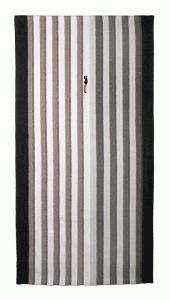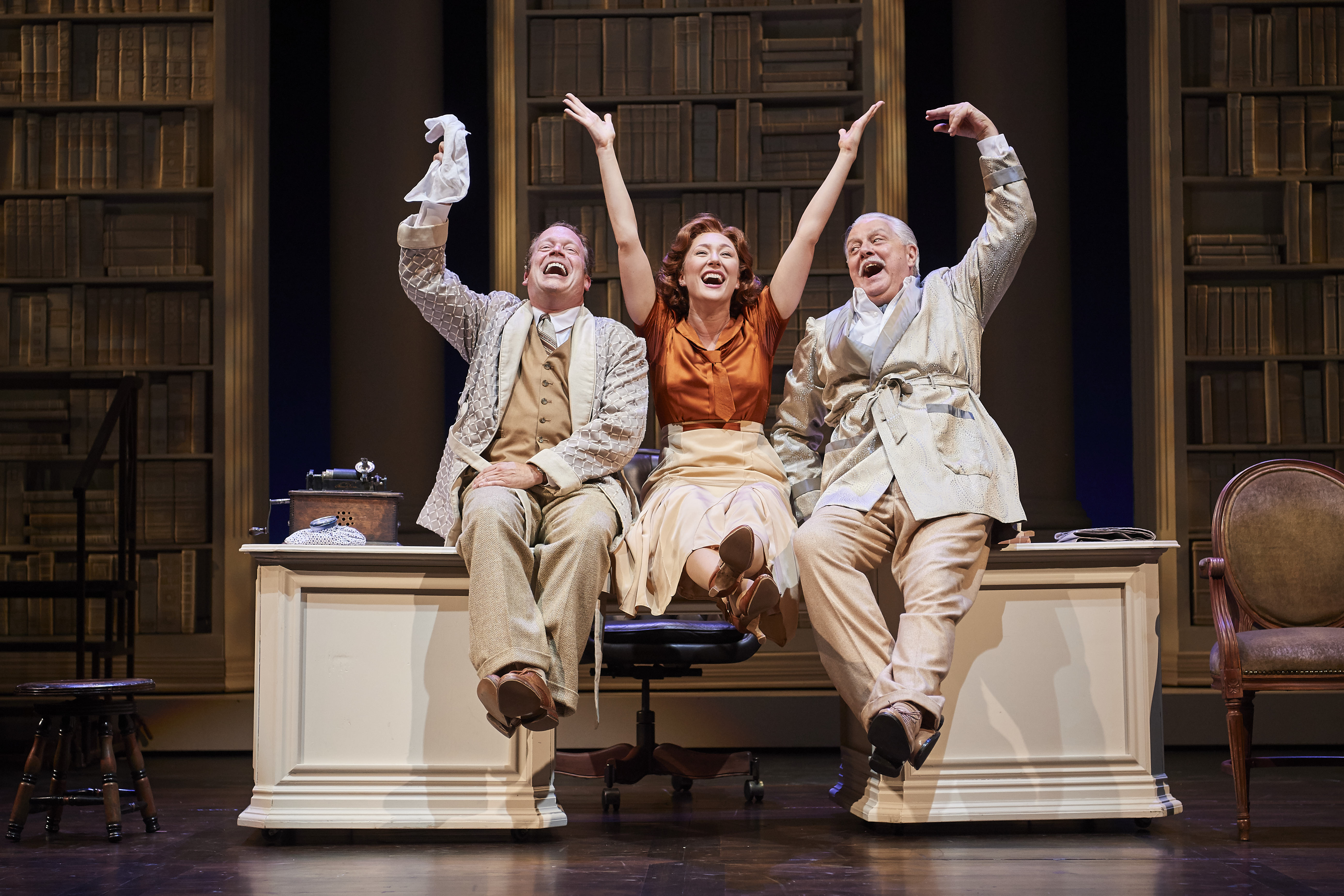Exhibitions at The Sculpture Center and the Artists Archives of the Western Reserve will return Lilian Tyrrell’s masterful artwork to the forefront – and lead visitors to discover the institutions’ tucked-away campus in University Circle
By Michael C. Butz

“Falling Man” by Lilian Tyrrell, 2003; wool and linen; 74 x 38 inches. Image courtesy of The Sculpture Center. This “Disaster Blanket” was made following the terrorist attacks of Sept. 11, 2001.
The scenes Lilian Tyrrell’s “Disaster Blankets” depict are historically significant and significantly challenging. Famine, terrorism and natural disasters are but a few of the themes Tyrrell brought to bear in her works, which when juxtaposed with the sense of comfort and security typically associated with blankets, confront viewers with some brutal realities of society.
Her efforts – awe-inspiring detail, painstaking craftsmanship and arresting imagery (sometimes pulled from news reports) – earned her the 1992 Cleveland Arts Prize. What’s more is that in the decades since, her work has remained strikingly relevant because many of the difficult topics she examined remain in the headlines today.
Tyrrell’s tapestries largely have been out of the public eye for years, however. That will change in September, when her work will figure centrally in exhibitions opening at The Sculpture Center and the Artists Archives of the Western Reserve, which share a campus in Cleveland’s University Circle neighborhood.
Tyrrell’s work was last widely seen at a 2006 retrospective at SPACES Gallery in Cleveland, shortly before her death in 2007 following her battle with a long-term illness. That exhibition resonated with Ann Albano, executive director and chief curator at The Sculpture Center.
“I thought the exhibition that SPACES did … was one of the most important exhibitions I’ve ever seen in Cleveland,” she says. “I was completely astonished by both the quality of her work and the topics she was addressing. … I’d never forgotten the work, and thought about it often, and then with everything that’s been going on politically in this country and internationally, it came back to me.”
The Sculpture Center will host “The Nowness of Then: Lilian Tyrrell’s Disaster Blankets,” as well as a complementary group show titled “Objections and Connections, Fiber Artists Talk Back,” starting Sept. 15. That same night, the Artists Archives of the Western Reserve will open a group show of its own, “In the Details,” which will include one of Tyrrell’s blankets.
“I think all of the work is still relevant, which is incredibly upsetting. There’s still famine, there’s still war, there’s still environmental concerns,” says Mindy Tousley, Artists Archives executive director. “Lilian is someone who had an international reputation, so we think of her maybe in terms of that show at SPACES, but that work was actually shown in different venues around the country, and I think, internationally.”

“Cradleboard: 10 of Potholders (coins) in the Kitchen Tarot” (detail) by Susan Shie, 2016, 60 x 90 inches. Image courtesy of the Artists Archives of the Western Reserve.
“In the Details,” curated by textile artist Mary Urbas, gallery coordinator at Lakeland Community College in Kirtland, will emphasize the handwork of the artists featured. The show will include artists Susan Shie and Libby Chaney, who, like Tyrrell, infuse political statements into their work.
“Susie Shie, who’s from Wooster, has for years made political statements in her work,” Tousley says. “It’s very different work than Lilian’s. I think it’s more personal, it comes out of a kind of stream-of-consciousness diary writing about whatever is on her mind at the time. And what seems to be on her mind, especially since George W. Bush was elected, is the administrations of our government.”
The Sculpture Center’s second exhibition, “Objections and Connections,” will showcase fiber artists who, like Tyrrell, glean artistic inspiration from mass media or other publically accessible landscapes.
Pittsburgh artist Penny Mateer creates photographic collages using only photographs from The New York Times, Albano explains, and the ones she thinks are particularly strong she takes to Walmart to be made into fleece blankets.
“She was the last artist I found, and when she said ‘fleece blankets,’ I nearly fell out of my chair because (there) became, instantly, (a parallel between) the Disaster Blankets and fleece blankets,” Albano says. “I think even the least-prepared visitor will make the connection.”
Also in the show will be Cleveland-based artist Lauren Davies, whose “Industry Unraveled” series consists of large tapestries on which photographs of Northeast Ohio’s deteriorating buildings are printed. The fabrics are then unraveled to symbolize the disappearing industry and decaying properties present throughout the region.
“She brings in both the unraveling of norms, which I think is a lot of what Lilian Tyrrell was also talking about in her work,” Albano says, “and that brings in the environmental problems of our area, which are so very clear when you look at these disintegrating buildings.”
‘The place to be discovered’

“The Last Hope” by Lilian Tyrrell, 1991; wool, metallic thread, cotton, linen, and other fibers; 84 x 112 inches. Images courtesy of The Sculpture Center.

“The Last Hope” by Lilian Tyrrell, 1991; wool, metallic thread, cotton, linen, and other fibers; 84 x 112 inches detail image. Images courtesy of The Sculpture Center.
Despite their shared geography, schedules allow The Sculpture Center and Artists Archives of the Western Reserve to hold only two campus-wide openings each year, once at the beginning of the year and once in the fall.
However, ties between the two nonprofits run deep.
Both were founded by visionary artist David E. Davis. The Sculpture Center began in 1989 when Davis, whose practice had been doing well, became increasingly concerned over whether sculptors graduating from the Cleveland Institute of Art would have opportunities to succeed as artists.
“He was concerned that when the students graduated, they couldn’t make a living and that they would have to leave the area to make a living,” Albano says. “He was hoping that if he could give them exhibition exposure through The Sculpture Center, it would be of help to them.”
Davis enlisted the help of fellow established artists to provide sculptors apprenticeships, and in 1990, the Window to Sculpture Emerging Artist Series was born.
“Then in the mid-’90s, probably some of the same artists who were helping the students, as well as other artists, began to think about their own futures and what to do about their work and started the Artists Archives,” Albano says.
A catalyst for the Artists Archives, Tousley says, was an experience in which Davis discovered a sculpture he’d been commissioned to make for a well-known collector’s home had been discarded and was scheduled to be bulldozed after the collector moved and sold the property. That incident drove home the realization that artists have little control over their work after they’ve sold pieces, so Davis set out to change that.
“The Archives was founded by David and eight other artists for artists who give them control over their legacy, which is really what we do,” Tousley says. “We cannot sell the work once it’s part of the collection. That’s very important. Once the work is here, an artist can be assured that it’s going to be cared for, it’s going to be preserved and future generations will be able to enjoy it.”

From left, Ann Albano, executive director and chief curator at The Sculpture Center, and Mindy Tousley, executive director of the Artists Archives of the Western Reserve, enjoy a moment in the sculpture garden that’s part of their organizations’ shared campus in University Circle. Photo by Michael C. Butz
The organizations’ differing roles – in a sense, The Sculpture Center ensures there is culture to preserve by supporting young artists, and the Artists Archives ensures culture will be preserved for future generations to take in – mean their respective audiences also differ. Campus-wide openings bring those audiences together.
“I really appreciate that crossover because the young people, the college students, who come to her exhibits then come over and often see things that are very relevant to them, or they will see artists they didn’t know about who are important to the history of the area,” Tousley says. “And on the other side, I will get our older artists who maybe need to be nudged a little bit into looking at things a little differently, and they get to keep up with what’s new and what’s emerging by going over to see what’s in Ann’s (galleries). I think the crossover is good for both.”
The joint openings also serve to raise the profile of both organizations. Though it’s just off of Euclid Avenue in University Circle, their campus is nestled between the Greater Cleveland RTA Red Line Rapid tracks and Lake View Cemetery and isn’t in the most highly traversed part of the neighborhood.
“The fact we are a little bit hidden, I think, can work to our advantage,” Tousley says. “We’re a little bit like a secret that’s being kept – and people love to find a secret.
“We’re the hidden garden back here, a little bit. That’s going to change as University Circle expands and grows, which it’s doing. We won’t be hidden anymore, but right now, we’re the place to be discovered.” CV
On View
The Artists Archives of the Western Reserve / The Sculpture Center
A campus-wide opening reception will be held for the Artists Archives of the Western Reserve’s “In the Details” and The Sculpture Center’s “The Nowness of Then: Lilian Tyrrell’s Disaster Blankets” and “Objections and Connections, Fiber Artists Talk Back” from 5:30 to 8 p.m. Sept. 15 at 1834 E. 123rd St., Cleveland.
Both shows at The Sculpture Center will be on view from Sept. 15 to Oct. 27. “Objections and Connections” will feature the work of William Marcellus Armstrong, Lauren Davies, Trey Gehring, Penny Mateer, Kathryn Shinko and Sarah Wiideman. Artists present at the opening reception will speak at 6:15 p.m. in the Euclid Avenue Gallery. Also at the opening reception, Brinsley Tyrrell, Lilian Tyrrell’s husband, is scheduled to speak at 7 p.m. in The Sculpture Center Main Gallery.
The Artists Archives of the Western Reserve’s “In the Details,” curated by Mary Urbas, will be on view from Sept. 15 to Nov. 4. and will feature the work of Libby Chaney, Juli Edberg, Sandy Miller, Jessica Pinsky, Gayle Vickery Pritchard, Susan Shie, Deborah Silver, Lilian Tyrrell, Archived Artist Evelyn Ward and Jennifer Whitten. Related, as part of Artists Archives’s “ART BITES” series of programs, “Quilting Today” with Tracy Rieger will be held from 1 to 3 p.m. Oct. 7.
Lead image: “Collateral Damage” by Lilian Tyrrell, 1992; Wool, silk, metallic thread and linen; 84 x 120 inches. Courtesy of The Sculpture Center.











